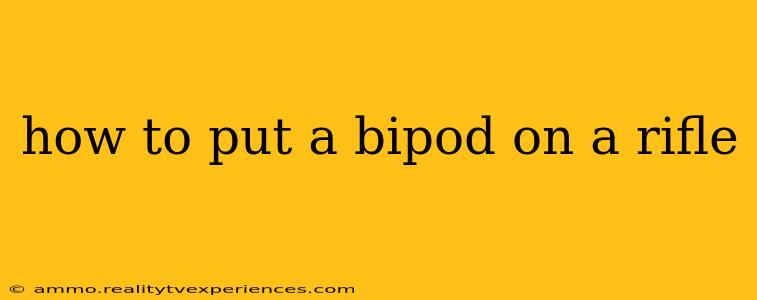Attaching a bipod to your rifle might seem straightforward, but understanding the different mounting methods and ensuring a secure fit is crucial for accuracy and stability. This guide covers various attachment techniques, offering tips for optimal performance and troubleshooting common issues. Whether you're a seasoned shooter or a newcomer to precision shooting, this detailed walkthrough will equip you with the knowledge to confidently mount your bipod.
Understanding Bipod Mounting Systems
Before diving into the installation process, it's essential to identify your bipod's mounting system. Most bipods utilize one of the following:
1. Picatinny/Weaver Rail Attachment
This is the most common method. Picatinny and Weaver rails are standardized mounting interfaces found on many rifles and accessories. Bipods designed for these rails typically use a clamping mechanism that secures the bipod firmly to the rail.
How to attach a bipod with a Picatinny/Weaver rail mount:
- Align the bipod: Carefully align the bipod's mounting clamp with the rail, ensuring it's positioned correctly.
- Tighten the clamp: Securely tighten the clamping screw(s) using the appropriate tool (usually a wrench or Allen key). Ensure the clamp is snug but avoid over-tightening, which could damage the rail or bipod.
- Test the stability: Gently move the rifle to check the bipod's stability. It should be firmly attached and not wobble.
2. Swivel Stud Attachment
Some rifles feature a swivel stud on the forend, specifically designed for attaching accessories like bipods. Bipods utilizing this method typically have a threaded stud that screws onto the rifle's swivel stud.
How to attach a bipod with a swivel stud mount:
- Screw the bipod onto the stud: Carefully screw the bipod's threaded stud onto the rifle's swivel stud, ensuring a secure connection.
- Tighten securely: Tighten the stud until it's firmly attached to the rifle. Over-tightening can strip the threads.
- Check for stability: Gently move the rifle to verify the bipod's stability and secure attachment.
3. Sling Swivel Stud Attachment
Similar to swivel stud attachment, this method uses a sling swivel stud for mounting, often requiring an adapter. The adapter will convert the sling stud into a bipod mounting point.
How to attach a bipod using a sling swivel stud adapter:
- Attach the adapter: Securely attach the adapter to the sling swivel stud, following the manufacturer's instructions.
- Mount the bipod: Attach the bipod to the adapter, ensuring a tight and secure connection.
- Test the connection: Gently move the rifle to confirm stability and proper attachment.
Choosing the Right Bipod
Selecting the appropriate bipod is just as crucial as knowing how to attach it. Consider these factors:
- Rifle weight and caliber: Heavier rifles and higher calibers demand more robust bipods capable of withstanding recoil and providing stable support.
- Shooting style and position: Your shooting style influences the bipod's ideal features. Prone shooting might require longer legs, while benchrest shooting may prioritize a more compact design.
- Mounting options: Choose a bipod compatible with your rifle's mounting system.
- Material and construction: Durability and lightweight materials are desirable.
Troubleshooting Common Issues
- Loose attachment: Check the clamping screw(s) or stud connection for proper tightness.
- Wobbling: Ensure the bipod is correctly aligned with the rail or stud and that the connection is secure. A damaged rail or stud might also contribute to instability.
- Incompatibility: Confirm that the bipod is compatible with your rifle's mounting system. Adapters might be necessary.
Conclusion
Successfully attaching a bipod to your rifle involves understanding your bipod's mounting system and ensuring a secure fit. By following these steps and considering the factors discussed, you can enhance your shooting accuracy and stability. Remember to always consult your bipod's and rifle's manufacturer's instructions for specific guidance and safety precautions.

